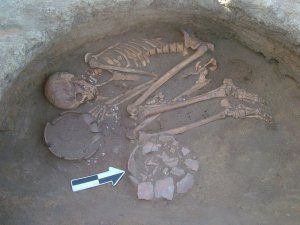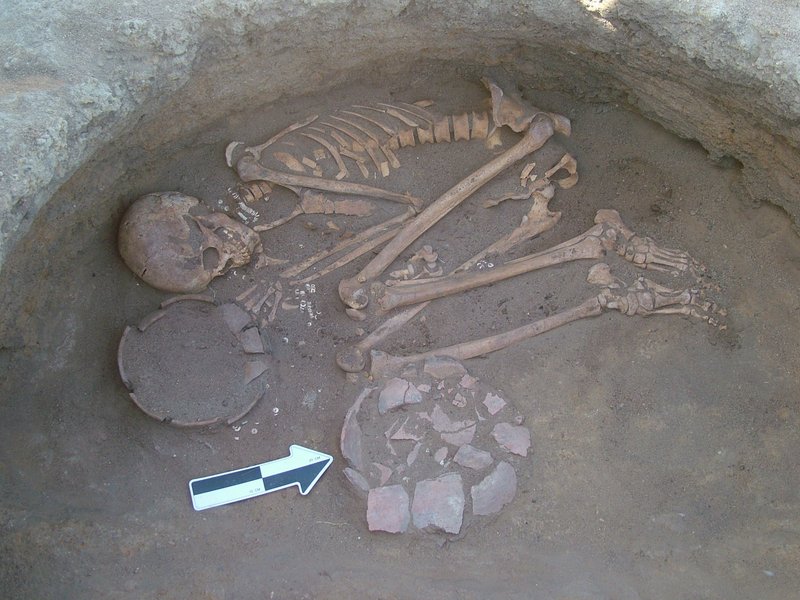
At a prehistoric site called Al Khiday, set along the White Nile in Central Sudan, archaeologist have uncovered evidence that shows prehistoric inhabitants there consumed significant quantities of a plant that contains both nutritional and medicinal qualities.
By sampling and analyzing chemical compounds and microfossils from the calcified dental plaque of human teeth from 14 individuals in burial grounds at the site spanning three different periods, the pre-Mesolithic, Neolithic, and Later Meroitic age, they were able to determine that humans ingested a specific plant, known as purple nut sedge, for at least 7,000 years, incorporating both pre-agricultural and agricultural periods. Widely regarded today as a weed and a nuisance, purple nut sedge apparently was an important staple in the diet of this prehistoric population, say the researchers in a study recently published in the journal PLOS ONE.
“By extracting material from samples of ancient dental calculus, we have found that rather than being a nuisance in the past, the purple nut sedge’s value as a food, and possibly its abundant medicinal qualities, were known,” says lead study author Karen Hardy. “We also discovered that these people ate several other plants, and we found traces of smoke, evidence for cooking, and for chewing plant fibres to prepare raw materials. These small biographical details add to the growing evidence that prehistoric people had a detailed understanding of plants long before the development of agriculture.”
________________________________
Above: One of the Late Meroitic graves excavated at the cemetery, that of a young male. Courtesy Donatella Usai/Centro Studi Sudanesi and Sub-Sahariani (CSSeS)
____________________________
The finding provides insight about how much prehistoric people knew about the ecology and potential therapeutic properties of plants. In addition to the nutritional benefits of purple nut sedge, for example, it inhibits a specific kind of Streptococcus that helps to lower the level of cavities. It explains why the teeth of the excavated skeletons at the site exhibited comparatively low levels of cavity formation.
The study is published in the July 16, 2014 issue of the open-access journal PLOS ONE by Stephen Buckley from the University of York and colleagues.
______________________________________
Source: Adapted and edited from a University of York press release.
The study: Buckley S, Usai D, Jakob T, Radini A, Hardy K (2014) Dental Calculus Reveals Unique Insights into Food Items, Cooking and Plant Processing in Prehistoric Central Sudan. PLoS ONE 9(7): e100808. doi:10.1371/journal.pone.0100808
Funding: Archaeological fieldwork was funded by The Italian Minister of Foreign Affairs, Istituto Italiano per l’Africa e l’Oriente, Centro Studi Sudanesi e SubSahariani. The equipment used belongs to Pharos Research (UK) and Spanish Ministry of Science and Innovation research project (grant number HAR2012-35376). The research described in this submission was unfunded. The funders had no role in study design, data collection and analysis, decision to publish, or preparation of the manuscript.
______________________________________
Read about the most fascinating discoveries with a premium subscription to Popular Archaeology Magazine. Find out what Popular Archaeology Magazine is all about. AND MORE:
On the go? Get the smartphone version of Popular Archaeology as an app or as an ebook.
Popular Archaeology’s annual Discovery Edition eBook is a selection of the best stories published in Popular Archaeology Magazine in past issues, with an emphasis on some of the most significant, groundbreaking, or fascinating discoveries in the fields of archaeology and paleoanthropology and related fields. At least some of the articles have been updated or revised specifically for the Discovery edition. We can confidently say that there is no other single issue of an archaeology-related magazine, paper print or online, that contains as much major feature article content as this one. The latest issue, volume 2, has just been released. Go to the Discovery edition page for more information.







